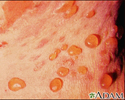Bullous pemphigoid
Bullous pemphigoid is a skin disorder characterized by blisters.
Bullous pemphigoid is an autoimmune disorder that occurs when the body's immune system attacks and destroys healthy body tissue by mistake. Specifically, the immune system attacks the proteins that attach the top layer of skin (epidermis) to the bottom layer of skin.
This disorder usually occurs in older persons and is rare in young people. Symptoms come and go. The condition often goes away within 5 years.
In some cases, the condition is triggered by a medicine.
Symptoms
Most people with this disorder have itchy skin that may be severe. In most cases, there are blisters, called bullae.
- Blisters are usually located on the arms, legs, or middle of the body. In rare cases, blisters can form in the mouth.
- The blisters may break open and form open sores (ulcers).
Exams and Tests
The health care provider will examine the skin and ask about the symptoms. They will review your list of medicines.
Tests that may be done to help diagnose this condition include:
- Blood tests
- Skin biopsy of the blister or the area next to it
Treatment
Anti-inflammatory medicines called corticosteroids may be prescribed. They may be taken by mouth or applied to the skin. More powerful medicines may be used to help suppress the immune system if steroids do not work, or to allow lower steroid doses to be used.
Antibiotics in the tetracycline family may be useful. Niacin (a B complex vitamin) is sometimes given along with tetracycline.
Your provider may suggest self-care measures. These may include:
- Applying anti-inflammatory creams to the skin
- Using mild soaps and applying moisturizer to the skin after bathing
- Protecting the affected skin from sun exposure and injury
Outlook (Prognosis)
Bullous pemphigoid usually responds well to treatment. The medicine can often be stopped after several years. The disease sometimes returns after treatment is stopped.
Possible Complications
Skin infection is the most common complication.
Complications resulting from treatment may also occur, especially from taking corticosteroids.
When to Contact a Medical Professional
Contact your provider if you have:
- Unexplained blisters on your skin
- An itchy rash that continues despite home treatment
References
Dinulos JGH. Vesicular and bullous diseases. In: Dinulos JGH, ed. Habif's Clinical Dermatology. 7th ed. Philadelphia, PA: Elsevier; 2021:chap 16.
Peña S, Werth VP. Bullous pemphigoid. In: Lebwohl MG, Heymann WR, Berth-Jones J, Coulson IH, eds. Treatment of Skin Disease: Comprehensive Therapeutic Strategies. 5th ed. Philadelphia, PA: Elsevier; 2018:chap 33.
Review Date: 4/14/2021
Reviewed By: Elika Hoss, MD, Senior Associate Consultant, Mayo Clinic, Scottsdale, AZ. Also reviewed by David Zieve, MD, MHA, Medical Director, Brenda Conaway, Editorial Director, and the A.D.A.M. Editorial team.







